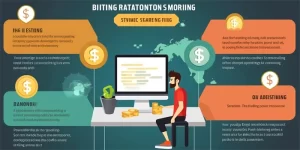YouTube has emerged as one of the biggest platforms for content creators to showcase their talent and potentially earn a substantial income. In India, with a growing internet user base and the popularity of online video consumption, many individuals are exploring the potential to make money on YouTube. However, the amount of money one can earn on the platform depends on various factors. In this article, we will delve into the different aspects that influence YouTube income in India.

1. Ad Revenue
Ad revenue is the primary source of income for most YouTubers in India. The amount of money earned through ads is influenced by factors such as the number of views, location of viewers, and the overall engagement on the videos. Ad revenue is typically determined by the number of ads shown before, during, or after the video.
The more popular a YouTube channel becomes, the higher the potential for ad revenue. However, ad revenue can vary significantly based on the content niche, target audience, and the seasonality of advertisers’ budgets.
2. YouTube Partner Program (YPP)
The YouTube Partner Program allows creators to monetize their videos through ads, channel memberships, and merchandise shelf. To be eligible for the program in India, channels need to have a minimum of 1,000 subscribers and 4,000 watch hours in the past 12 months. Joining the YPP opens up additional income streams beyond ad revenue.
3. Sponsored Content
As a YouTube channel gains popularity, creators often receive offers for sponsored content collaborations. Brands approach successful YouTubers to feature their products or services in their videos, providing a new source of income. The amount earned through sponsored content depends on the channel’s reach and the brand’s budget.
It is crucial for creators to maintain transparency and credibility while incorporating sponsored content to retain their audience’s trust.
4. Channel Memberships
YouTube channel memberships allow creators to offer exclusive perks to their subscribers at a monthly fee. These perks may include early access to videos, behind-the-scenes content, or personalized interactions. The income generated from channel memberships depends on the number of loyal subscribers willing to avail such benefits and support their favorite creators.
5. Merchandise Sales
Many YouTubers expand their brand beyond the platform and venture into merchandise sales. They create and sell branded products, including t-shirts, accessories, or digital products like e-books or online courses. The income from merchandise sales is influenced by the channel’s popularity, the appeal of the products, and effective marketing strategies.
6. YouTube Premium
YouTube Premium is a subscription-based service that allows users to enjoy an ad-free experience while supporting their favorite creators. A portion of the monthly subscription fee paid by YouTube Premium members is distributed among the creators based on watch time on their videos. The revenue from YouTube Premium depends on the number of premium subscribers watching the creator’s videos.
7. Live Streaming and Super Chat
Live streaming on YouTube provides an opportunity for creators to engage with their audience in real-time. During live streams, viewers can make monetary contributions through Super Chat, which lets them highlight their messages. The income from live streaming and Super Chat depends on the popularity of the channel, the duration of live sessions, and the level of viewer interaction.
8. Affiliate Marketing
Creators often collaborate with affiliate programs or networks and promote products or services in their videos. They earn a commission on the sales generated through their unique affiliate links. The income from affiliate marketing depends on the effectiveness of promotions, audience interest in the products, and the commission rates offered by the affiliate programs.
9. Crowdfunding
Some creators turn to crowdfunding platforms like Patreon or Kickstarter to receive direct financial support from their audience. In exchange for their contributions, supporters may receive exclusive benefits or personalized content. The income from crowdfunding platforms depends on the loyalty and size of the creator’s fanbase.
10. YouTube Shorts Fund
The YouTube Shorts Fund is a program introduced by YouTube to incentivize creators to produce short-form content on the platform. Eligible creators receive a share of the fund based on the performance and engagement of their YouTube Shorts videos. The income from the Shorts Fund varies depending on the creator’s Shorts viewership and overall program budget.
11. Grants and Contests
In some cases, YouTube grants and contests allow creators to win monetary prizes based on the quality and uniqueness of their content. These opportunities provide additional income for creators who participate and excel in such programs.
12. Licensing and Syndication
Successful creators often explore licensing or syndicating their content to external platforms, media outlets, or broadcast networks. Licensing agreements enable creators to earn money based on the usage or distribution of their videos beyond YouTube. The income from licensing and syndication depends on the reach and demand for the creator’s content.
13. Brand Collaborations
Brands may approach YouTube creators for collaborations outside of traditional sponsored content. This may include hosting events, featuring in brand campaigns, or participating in influencer marketing initiatives. The income from brand collaborations varies depending on the scope of the partnership, the brand’s budget, and the creator’s reputation.
14. Supplementary Online Platforms
Many creators utilize additional online platforms like Patreon, OnlyFans, or Ko-fi to offer exclusive content or services to their most loyal followers. Income generated from these supplementary platforms depends on the creator’s ability to provide unique offerings and their audience’s willingness to support them financially.
15. External Opportunities
YouTube success can open doors to external opportunities such as book deals, brand endorsements outside of YouTube, speaking engagements, or even television appearances. Income from these opportunities depends on the creator’s negotiation skills, industry demand, and their influence in the respective field.
In conclusion, the income potential on YouTube in India is vast, but it varies depending on various factors such as ad revenue, sponsorship opportunities, memberships, merchandise sales, and others. Building a successful YouTube channel requires dedication, consistency, and providing valuable content that resonates with the target audience.
References:
1. YouTube Partner Program: https://support.google.com/youtube/answer/72857
2. YouTube Premium: https://support.google.com/youtube/answer/6307365
3. Patreon: https://www.patreon.com
About the author:
[Author Name] is an experienced content creator and digital strategist. With a deep understanding of YouTube’s monetization landscape, they have helped several creators optimize their revenue streams. The author firmly believes in the power of YouTube as a platform for aspiring content creators, constantly exploring innovative ways to maximize growth and income. [Author Name] enjoys capturing unique moments through photography, and the accompanying image in this article is an original creation by the author.








